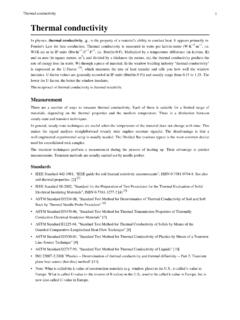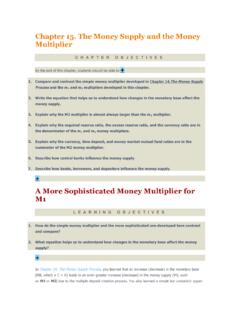Transcription of Information Systems for Business and Beyond
1 Information Systems for Business and Beyond David T. Bourgeois, Saylor URL: Attributed to: David T. Bourgeois, 1 Introduction Part 1: What Is an Information System? Chapter 1: What Is an Information System? 5 David T. Bourgeois Chapter 2: Hardware 14 David T. Bourgeois Chapter 3: Software 26 David T. Bourgeois Chapter 4: Data and Databases 39 David T. Bourgeois Chapter 5: Networking and Communication 52 David T. Bourgeois Chapter 6: Information Systems Security 64 David T. Bourgeois Part 2: Information Systems for Strategic Advantage Chapter 7: Does IT Matter? 76 David T. Bourgeois Chapter 8: Business Processes 85 David T.
2 Bourgeois Chapter 9: The People in Information Systems 94 David T. Bourgeois Chapter 10: Information Systems Development 104 David T. Bourgeois Part 3: Information Systems Beyond the Organization Chapter 11: Globalization and the Digital Divide 120 David T. Bourgeois Chapter 12: The Ethical and Legal Implications of Information Systems 129 David T. Bourgeois Chapter 13: Future Trends in Information Systems 144 David T. Bourgeois 150 Answers to Study Questions 162 Bibliography iv Saylor URL: Attributed to: David T. Bourgeois, Saylor URL: Attributed to: David T. Bourgeois, IntroductionWelcome toInformation Systems for Business and this book, you will be introduced to theconcept of Information Systems , their use in Business , and the larger impact they are having on our book is written as an introductory text, meant for those with little or no experience with computersor Information Systems .
3 While sometimes the descriptions can get a little bit technical, every effort hasbeen made to convey the Information essential to understanding a topic while not getting bogged down indetailed terminology or esoteric OutlineThe text is organized around thirteen chapters divided into three major parts, as follows: Part 1: What Is an Information System?Chapter 1: What Is an Information System? This chapter provides an overview ofinformation Systems , including the history of how we got where we are 2: Hardware We discuss Information Systems hardware and how it works. Youwill look at different computer parts and learn how they 3: Software Without software, hardware is useless.
4 In this chapter, we discusssoftware and the role it plays in an 4: Data and Databases This chapter explores how organizations useinformation Systems to turn data into Information that can then be used for competitiveadvantage. Special attention is paid to the role of 5: Networking and Communication Today s computers are expected to also becommunication devices. In this chapter we review the history of networking, how theInternet works, and the use of networks in organizations 6: Information Systems Security We discuss the Information security triad ofconfidentiality, integrity, and availability. We will review different security technologies,and the chapter concludes with a primer on personal Information security.
5 Part 2: Information Systems for Strategic AdvantageChapter 7: Does IT Matter? This chapter examines the impact that Information systemshave on an organization. Can IT give a company a competitive advantage? We will1 Saylor URL: Attributed to: David T. Bourgeois, URL: Attributed to: David T. Bourgeois, discuss seminal works by Brynjolfsson, Carr, and Porter as they relate to IT andcompetitive 8: Business Processes Business processes are the essence of what a businessdoes, and Information Systems play an important role in making them work. This chapterwill discuss Business process management, Business process reengineering, and 9: The People in Information Systems This chapter will provide an overview ofthe different types of people involved in Information Systems .
6 This includes people whocreate Information Systems , those who operate and administer Information Systems , thosewho manage Information Systems , and those who use Information 10: Information Systems Development How are Information Systems created?This chapter will review the concept of programming, look at different methods ofsoftware development, review website and mobile application development, discuss end-user computing, and look at the build vs. buy decision that many companies face. Part 3: Information Systems Beyond the OrganizationChapter 11: Globalization and the Digital Divide The rapid rise of the Internet hasmade it easier than ever to do Business worldwide.
7 This chapter will look at the impactthat the Internet is having on the globalization of Business and the issues that firms mustface because of it. It will also cover the concept of the digital divide and some of the stepsbeing taken to alleviate 12: The Ethical and Legal Implications of Information Systems The rapidchanges in Information and communication technology in the past few decades havebrought a broad array of new capabilities and powers to governments, organizations, andindividuals alike. This chapter will discuss the effects that these new capabilities have hadand the legal and regulatory changes that have been put in place in 13: Future Trends in Information Systems This final chapter will present anoverview of some of the new technologies that are on the horizon.
8 From wearabletechnology to 3-D printing, this chapter will provide a look forward to what the next fewyears will the StudentEach chapter in this text begins with a list of the relevant learning objectives and ends with a chaptersummary. Following the summary is a list of study questions that highlight key topics in the chapter. Inorder to get the best learning experience, you would be wise to begin by reading both the learning objectivesand the summary and then reviewing the questions at the end of the Information Systems for Business and Beyond URL: Attributed to: David T. Bourgeois, For the InstructorLearning objectives can be found at the beginning of each chapter.
9 Of course, all chapters are recommendedfor use in an introductory Information Systems course. However, for courses on a shorter calendar orcourses using additional textbooks, a review of the learning objectives will help determine which chapterscan be the end of each chapter, there is a set of study questions and exercises (except for chapter 1, whichonly offers study questions). The study questions can be assigned to help focus students reading on thelearning objectives. The exercises are meant to be a more in-depth, experiential way for students to learnchapter topics. It is recommended that you review any exercise before assigning it, adding any detail needed(such as length, due date) to complete the 3 URL: Attributed to: David T.
10 Bourgeois, Part 1: What Is an Information System? URL: Attributed to: David T. Bourgeois, Chapter 1: What Is an Information System? David T. Bourgeois Learning Objectives Upon successful completion of this chapter, you will be able to: define what an Information system is by identifying its major components; describe the basic history of Information Systems ; and describe the basic argument behind the article Does IT Matter? by Nicholas Carr. Introduction If you are reading this, you are most likely taking a course in Information Systems , but do you even know what the course is going to cover?












